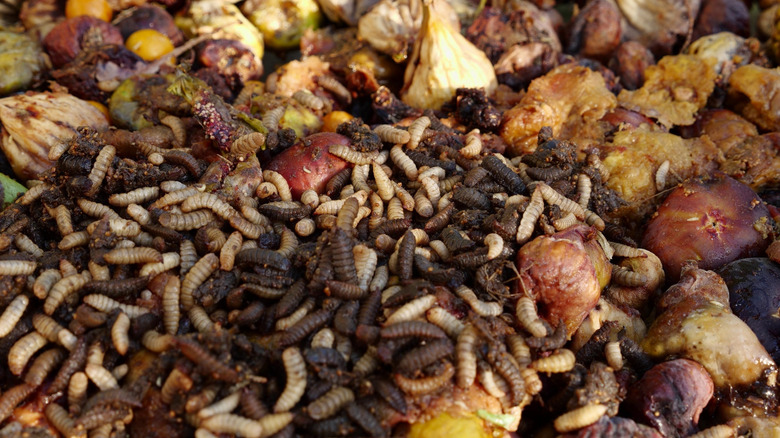Why There's Maggots In Your Compost (And How To Get Rid Of Them)
Composting as a garden owner is almost a no-brainer. There are so many benefits of composting to your plants, the environment, and soil that it just makes sense to set up a compost bin in your home. However, you might be surprised to find that your composting endeavor has attracted some unwanted guests: maggots. The maggots you'd usually find in your compost are the larval stage of the compost-dwelling Black Soldier fly (Hermetia illucens). Flies lay their eggs in places that are moist and rich in food for their larvae. You'll usually find these when your compost has too much food waste and greens or you don't turn the pile often enough, which leaves areas of moisture for maggots to thrive. Now, many people might tell you that maggots in your compost bin aren't a bad thing, and they'd be right.
Maggots help accelerate the composting process by breaking down organic material into smaller pieces that are easier to decompose. Additionally, maggots typically develop a dark-brown, tough-looking skin as they age. Once they pupate, their skin will decompose, adding some nitrogen and glucose to your compost. But these squirming, wriggling guests can be an unwelcome sight if you don't have the stomach for it. Beyond their look, these maggots are an indicator of something worse in the future, which are flies. This can be terrible if you have an indoor compost setup, as they can become a nuisance in your home unless you take steps to get rid of the flies. Thankfully, there are a number of ways to send maggots packing, including making changes to your compost pile.
How to get rid of maggots in your compost
You can start by getting the composition of your compost back in order. Add some browns into the mix. These items are rich in carbon and are great for absorbing the moisture that maggots thrive in. They'll dry out the compost, making it less conducive for the pests. Some great browns you can add include shredded newspaper or cardboard, shredded egg boxes, and dried leaves. Next, you can add a bit of lime to your compost. This will increase the pH of your compost, making it unappealing for maggots. However, you should be careful with the way you add lime, as it can make most of your compost alkaline, and you may not want that.
Stirring your compost pile is another good way to combat these maggots. If you've added some browns into the mix, turning the pile would cause the compost to heat up. Soldier fly larvae can't survive in temperatures above 113 degrees Fahrenheit, and you can achieve that when you turn your compost, killing off the maggots. While all these methods of removing maggots are effective, you may be better off cutting them off at the source. Employ a few natural means of keeping flies out of your home, and they won't be around to lay eggs in your compost.

